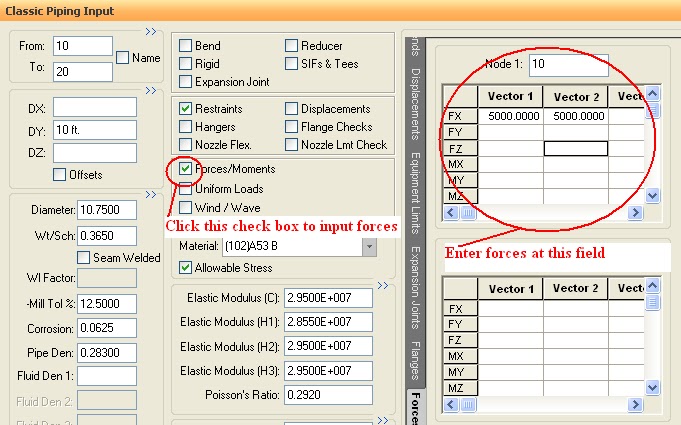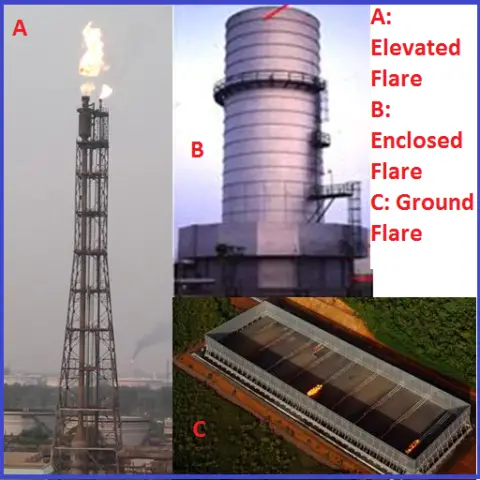PSV or pressure safety valves are very common to any process industry. To protect any equipment from overpressure PSV systems are used in lines. Two types of PSVs are extensively used in process industries: a) Open discharge PSV and b) Closed discharge PSV. Due to any uncertain event if pressure of any equipment becomes higher than the set pressure of the installed PSV s then they pop up and reduce the system pressure. During popong up activity the PSVs exert huge reaction force over the system. During analysis of PSv connected stress systems we have to consider this reaction force. This is the main reason that PSV connected systems become stress critical. The following write up will try to explain the methods used during analysis of such systems using Caesar II.
Required Documents for analysis
The following documents are required while inputting in Caesar II.
- Stress isometrics
- P&ID and line list
- PSV datasheet with reaction force and PSV weights.
- Equipment GA and datasheet if equipment is part of the stress system.
Reaction force Application philosophy:
Before we start the actual analysis we should first know the reaction force. Normal practice is to obtain the reaction force from PSV vendor or manufacturer. However if during preliminary stage of analysis data is not available then the reaction force for open discharge PSVs can be calculated using the below mentioned formula (from API RP 520). But later it must be corrected for forces received from vendor.
Fig.1: Typical Open discharge PSV connection
Reaction force at the point of discharge in lbf, F=[(W/366)* √{K*T/(K+1)*M}]+A*P
Here, W=flow of any gas or vapour in lbm/hr
K=ratio of specific heats (Cp/Cv) at the outlet condition
T=temperature at the outlet in oR
M=molecular weight of the process fluid
A=area of the outlet at the point of discharge in inch^2
P=Static pressure within the outlet at the point of discharge in psig.
Cp and Cv=Specific heat at the constant pressure and at constant volume respectively.
For closed discharge PSV systems there is no specific method to calculate the reaction force. Complex time history analysis can be used to exactly calculate the reaction force for closed discharge PSV systems.
The reaction force application philosophy for open discharge PSV (PSV output discharges into atmosphere) connected systems is same throughout the process industries. But for closed discharge PSV connected system the force application philosophy varies from organisation to organisation. Few organisation applies the reaction force for closed dischare PSVs but few organisations does not consider it. So user to follow the company specific project guidelines is such cases.
Where to apply the reaction force:
The following figure (Fig. 2) shows the points where the reaction force is required to be applied for open discharge PSVs.
Fig.2: Reaction force Application point for open discharge PSV connected systems.
Fig. 3 shows the application point (If required) of reaction forces for closed discharge PSV connected systems.
Fig.3: Reaction force Application point for Closed discharge PSV connected systems.
Caesar II load cases for PSV connected systems:
PSV forces are considered as occassional forces. So occasional Stress due to PSV reaction force has to be calculated and to be limited within 1.33 times Sh (As per code ASME B 31.3). Here Sh=Basic allowable stress at hot condition. Based on company practise PSV reaction force is added either with Design temperature case or with operating temperature case. Also some organisations have the practise of making One PSV popping up and other stand by load cases. Accordingly make the load cases as shown below:
Fig.4: Caesar II methodology to enter the reaction force
Fig.5: Caesar II simple load cases for analysis PSV connected system
The following load cases assumes two temperatures (T1=Operating temp, T2=design temp) alongwith Wind and Seismic load cases:
L1. WW+HP HYD
L2. W+T1+P1 OPE —Operating temperature case
L3. W+T2+P1 OPE—-Design temperature case
L4. W+T1+P1+F1 OPE—Operating temp+PSV reaction ( PSV 1 poppoing up)
L5. W+T1+P1+F2 OPE—Operating temp+PSV reaction ( PSV 2 poppoing up)
L6. W+T1+P1+WIN1 OPE—Operating temp+Wind from North
L7. W+T1+P1+WIN2 OPE—Operating temp+Wind from South
L8. W+T1+P1+WIN3 OPE—Operating temp+Wind from East
L9. W+T1+P1+WIN4 OPE—Operating temp+Wind from West
L10. W+T1+P1+U1 OPE—Operating temp+Seismic from North
L11. W+T1+P1-U1 OPE—Operating temp+Seismic from South
L12. W+T1+P1+U2 OPE—Operating temp+Seismic from East
L13. W+T1+P1-U2 OPE—Operating temp+Seismic from West
L14. W+P1 SUS—Sustained case
L15. L4-L2 OCC—Pure PSV Reaction
L16. L5-L2 OCC—Pure PSV Reaction
L17. L6-L2 OCC—Pure Wind
L18. L7-L2 OCC—Pure Wind
L19. L8-L2 OCC—Pure Wind
L20. L9-L2 OCC—Pure Wind
L21. L10-L2 OCC—Pure Seismic
L22. L11-L2 OCC—Pure Seismic
L23. L12-L2 OCC—Pure Seismic
L24. L13-L2 OCC—Pure Seismic
L25. L15+L14 OCC—Pure Occasional+Sustained
L26. L16+L14 OCC—Pure Occasional+Sustained
L27. L17+L14 OCC—Pure Occasional+Sustained
L28. L18+L14 OCC—Pure Occasional+Sustained
L29. L19+L14 OCC—Pure Occasional+Sustained
L30. L20+L14 OCC—Pure Occasional+Sustained
L31. L21+L14 OCC—Pure Occasional+Sustained
L32. L22+L14 OCC—Pure Occasional+Sustained
L33. L23+L14 OCC—Pure Occasional+Sustained
L34. L24+L14 OCC—Pure Occasional+Sustained
L35. L2-L14 EXP—Pure Expansion
L36. L3-L14 EXP—Pure Expansion
Output Study:
- Check Code stresses for load cases L1, L14 and from L25 to L36. It is better to keep stresses for L1 and L14 below 60% and for the rest within 80%.
- Check forces for load cases from L1 to L14.
Few points to keep in mind:
- It is a better practice to use 3 way restraints in both inlet and outlet piping of PSV connected systems if feasible (As shown in figure 2 and 3 above). However if not possible then try to provide 3 way restraint in outlet only by layout modification.
- In normal operating case Safety valve inlet line temperature will be operating temperature up to inlet of safety valve and Safety valve outlet line will be in ambient temperature up to the header.
- Sometimes a Dynamic Load Factor (DLF) of 2 is used for calculating PSV reaction force.
- If any stress failure or abnormal routing changes are required, then certain local area from header can be used average temperature for 2 meters or 5D which is higher (Safety valve outlet joining at header junction point) and also shall be taken process engineer’s approval.
- If required stress engineer shall provide R.F pad for the trunnion type support.
- If connection of psv closed system is emerging from header with 45˚ put SIF for this tapping. If required tapping point of the outlet line and outlet header shall be reinforced to reduce SIF.
- In case of any safety valve assembly is placed on top platform of any vessel, Support can be taken either from top platform or support can be arranged from the top portion of vessel taking clip from the vessel. In both the cases the load and locations of support or clip equipment vendor must be informed though the mechanical group along with the clip information.
- Do not provide spring below safety valve inlet line
Note: Please reply in comments in case of any confusion or if you want to add something.









I feel the sign convention matches with that of CAESAR II convention. the direction of PSV outlet piping determines the direction (sign) of the force acting on the first elbow. It will be in the direction from PSV outlet towards first elbow, with CII sign convention (positive or negative)
I feel that entering force values in Vector 1 and Vector 2 at the same node is not correct. It has been done only for explanation, I feel by Mr. Dey. Vector 1 corresponds to F1 and should be entered for PSV-1 pop up case at elbow-1 node.
Vector 2 corresponds to F2 and should be entered for PSV-2 pop up case at elbow-2 node.
Hope this helps. Thanks.
I feel the sign convention matches with that of CAESAR II convention. the direction of PSV outlet piping determines the direction (sign) of the force acting on the first elbow. It will be in the direction from PSV outlet towards first elbow, with CII sign convention (positive or negative)
I feel that entering force values in Vector 1 and Vector 2 at the same node is not correct. It has been done only for explanation, I feel by Mr. Dey. Vector 1 corresponds to F1 and should be entered for PSV-1 pop up case at elbow-1 node.
Vector 2 corresponds to F2 and should be entered for PSV-2 pop up case at elbow-2 node.
Hope this helps. Thanks.
if we use proper guides to the inlet piping of psv why cant we provide the springs on the inlet piping. Sometimes in the temperature range of more than 330 deg cel resting support will not work in hot sustained case so we need to provide the springs. We cant use the loops as of limitations of the pressure drop.
In open system, also input reaction force at first bend to reached last point that open to atmospheric or not ?.
In close system, also input reaction force at next bend to reached header or not ?
would you please explain what is diffrence between “RV. POP CONDITION” AND “ESTABLISHED FLOW CONDITION” ?
also what is diffrence between load cases for these two condition?
Thank you for good text. I have wondering the open type SRV with vent pipe. Nonmandatory appendix of ASME B31.1 shows the calculation of the force in the vent pipe. The same rule could be applied to the vent pipe or any further consideration is required?